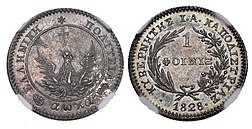Phoenix (currency)
| φοίνιξ (Greek) | |
|---|---|
 Silver one-phoenix coin, minted in Aegina by Count Ioannis Kapodistrias. Dated 1828. Obverse: phoenix rising from the ashes below a cross, symbol of the newly reborn Orthodox Christian Greek state, inscription 'ΕΛΛΗΝΙΚΗ ΠΟΛΙΤΕΙΑ' ('Hellenic State'). The letters αωκα represent 1821, the date of the Greek Declaration of Independence, in the Ancient Greek numeral system. The small anchor was the Aegina mint mark. Reverse: denomination '1 ΦΟΙΝΙΞ' ( '1 phoenix') inscription: 'ΚΥΒΕΡΝΗΤΗΣ Ι.Α. ΚΑΠΟΔΙΣΤΡΙΑΣ' ('Governor I.A. Kapodistrias') | |
| Denominations | |
| Subunit | |
| 1⁄100 | Lepton (Λεπτόν) |
| Plural | |
| Lepton (Λεπτόν) | Lepta (Λεπτά) |
| Demographics | |
| Date of introduction | 1828 |
| Replaced by | Drachma |
| User(s) | Greece |
| Issuance | |
| Central bank | Greece |
| This infobox shows the latest status before this currency was rendered obsolete. | |


The phoenix (
Introduction
The creation of a national currency was one of the most pressing issues for the newborn Greek state, so that the monetary chaos reigning in the country could subside. Prior to the Phoenix's introduction, transactions were settled with a wide variety of coins, including the kuruş; coins from major European states, such as France, Britain, Russia and Austria, were also popular. Therefore, minting the phoenix was one of Governor Kapodistrias' greatest priorities, and he signed a decree authorising it on 12 April 1828. The Russian Imperial government lent Kapodistrias' administration 1.5 million roubles to start the project.
Minting the Phoenix
Kapodistrias made Alexandros Kontostavlos responsible for minting the Phoenix. Kontostavlos travelled to Malta, where he negotiated the purchase of several coin presses, originally owned by the Knights Hospitaller. The machines were brought to Aegina.
The dies for the Phoenix were carved by
Demise
Only a small number of coins were minted, estimated to just under twelve thousand
References
- ISBN 960-91397-3-6.
- ^ L. Krause, A. Karamitsos.
- Krause, Chester L.; Clifford Mishler (1991). ISBN 0873411501.
- Pick, Albert (1994). ISBN 0-87341-207-9.

